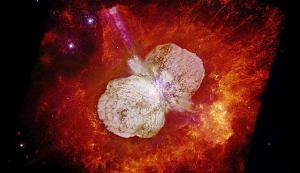Blog
The Great Eruption
12 September 2014
 NASA/Hubble
NASA/HubbleEta Carinae is a star visible in the southern hemisphere with a rather curious history. It was first cataloged in the 1600s as a 4th magnitude star, but by the time it was given the name Eta Carinae in the 1700s it was a 2nd magnitude star. By the early 1900s it had faded to an 8th magnitude star, but then toward the end of the twentieth century it had brightened to a 5th magnitude star. However its biggest change occurred around 1841, and became known as the great eruption.
Eta Carinae was once thought to be the most luminous star known. We now know it is actually a double star, and its primary is still a very bright type of star known as luminous blue variable (LBV). The reason it typically doesn’t appear bright is because it is about 8,000 light years away, and much of the light can be obscured by the dust of its surrounding nebula, known as the Homunculus Nebula. The thing about LBVs is that they can undergo dramatic brightening, as happened with Eta Carinae in the 1840s.
Around 1840, Eta Carinae began brightening noticeably. In 1841 its brightness underwent a dramatic spike, and by 1843 it had become the second brightest star in the sky. At its peak, Eta Carinae was blasting away about two solar masses worth of material. Its brightness had increased so quickly and so significantly that it looked almost like a supernova. But with supernovae the star is ripped apart. Eta Carianae survived this explosion, so it is sometimes known as a supernova impostor.
In 2012 light echoes from the great eruption were observed.1 These occur when light from the original explosion reflect off of more distant dust clouds, causing them to brighten. While observations of these echoes confirm the timing of the great eruption, it also raises more questions than it answers. The working model for the event is that it is triggered by light pressure on the outer layers of the star. Basically, the star becomes so luminous that light pressure pushes the outer layers of the star away, causing it to brighten significantly. But observation of the light echoes found that the temperatures of the great eruption were much cooler than necessary for light pressure to work. So there must be some other mechanism that triggered the event, and we aren’t sure what that could be.
Because the great eruption wasn’t a supernova explosion, it is quite likely that Eta Carinae will become a supernova at some point in the future. In the past decade there has been a measurable brightening of the star, which has led some to claim that Eta Carinae could go supernova “any day now,” with the corresponding doomsday scenario. But even if the star were to explode as a hypernova, 100 times brighter than a typical supernova, it won’t mean the end of life on Earth. The most likely outcome would be a brilliant blue star lasting for a few months. It would be brighter than the Moon at maximum brightness, and would be bright enough to read by, but it won’t vaporize our ozone or anything significant, as some unnamed TV shows claim.
Actually if it does go supernova (or similarly if Betelgeuse does), it would actually be a boon for astronomers. We’d love to observe a close supernova with modern instruments, and because of the luck of the draw we haven’t had the chance.
Rest, A., et al. “Light echoes reveal an unexpectedly cool η Carinae during its nineteenth-century Great Eruption.” Nature 482.7385 (2012): 375-378. ↩︎